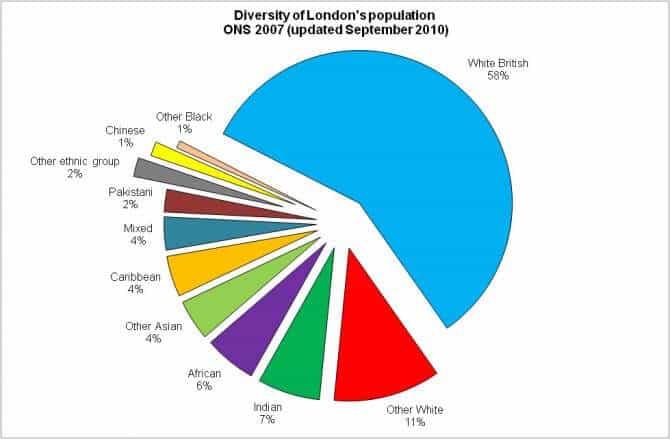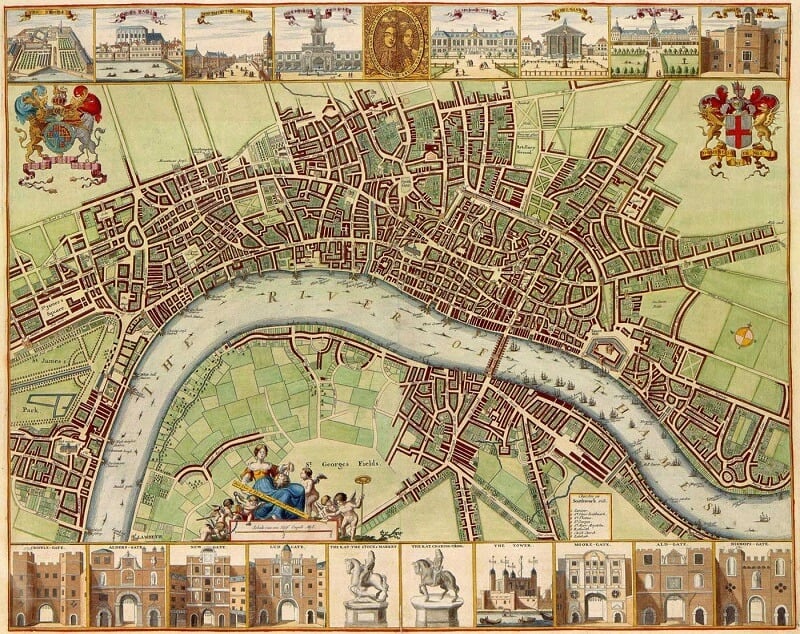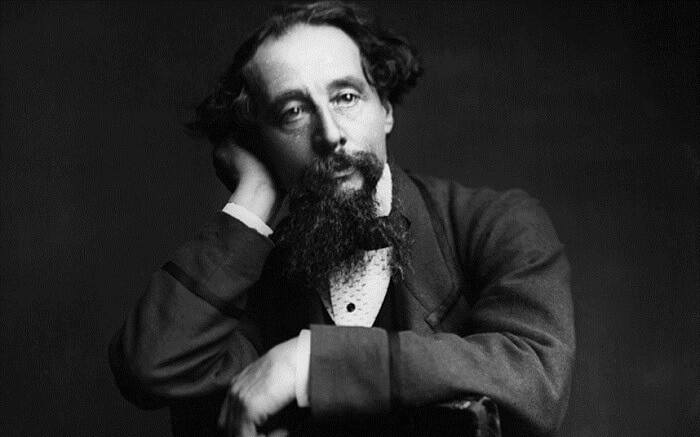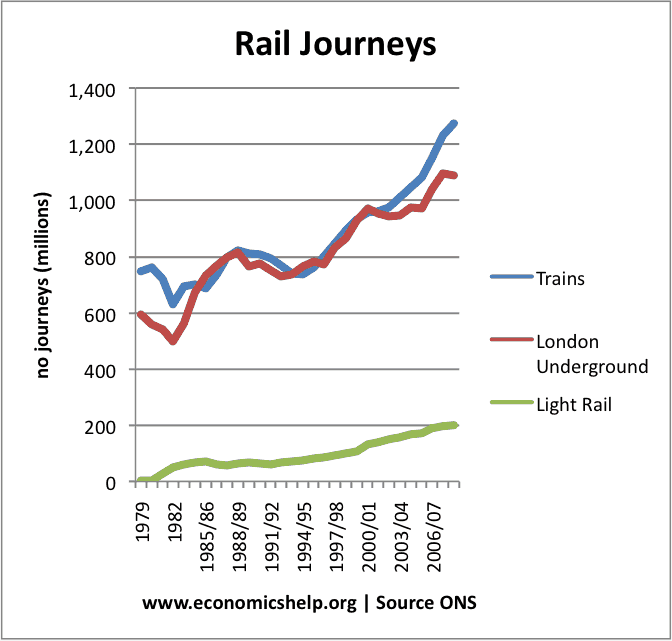London Is the Most Populous City in Europe
London is one of the largest and most exciting cities in Europe. Located on the banks of the River Thames, it has been a major world capital for centuries. There are plenty of intriguing London facts relating to the city’s large and diverse population, with current figures suggesting that there are 8.3 million people in the city proper, and over 13 million in the metropolitan area. Within this large population, a 2011 census estimated that 44.9% of Londoners were White British in ethnicity. Other large ethnic groups included Asian, which accounted for 20.9% of the city’s population, and Black, which made up 15.6%. These figures show that London is one of the most diverse cities in the world and, indeed, it is thought that over 300 languages are spoken in the city today.
London Is Britain’s Number One Tourist Destination
A recent study of London facts suggested that in 2013, the city was visited by 16.8 million tourists. This is unsurprising when you consider the large number of historical and modern attractions the city contains. The city has four World Heritage Sites; the site of the Palace of Westminster and Westminster Abbey, the Tower of London, Kew Gardens, and Greenwich, which contains the Royal Observatory. There are many other famous sites too − Buckingham Palace, , Trafalgar Square, Tower Bridge and the London Eye to name just a few.
It’s Home to the West End, the British Museum and the Tate Modern
London also boasts some impressive cultural life. Along with thousands of bars, restaurants, shops and clubs, London is known for its famous theaters. These theaters are largely located in the West End, an area which contains 40 venues and has a long history as one of Europe’s major theatrical areas. The South Bank of the Thames has also become a major cultural center in recent years, hosting the National Theatre and the Old Vic, along with the British Film Institute. As well as famous entertainment activities, London also excels in museums and galleries, including the British Museum, Victoria and Albert Museum, Tate Modern, British Library and more. The city also contains eight royal parks, the most famous of which is Hyde Park in central London.
We Can Thank the Romans for London
Although there is evidence of small settlements in the Thames area before the Roman invasion, when we discuss London facts it must be said that the city was really founded by them. The Romans invaded Britain in 55 BCE, and founded a settlement in the London area around 43 CE. This was stormed and burned by Celtic tribes, but they rebuilt it, naming the city Londinium. It became the capital of Roman Britain until the Romans left in the 5th century and, for a while, the walled city was almost abandoned. From the middle of the 6th century however, the Anglo-Saxon settlement Lundenwic developed just to the west of the Roman walled city. It became a major port but was assaulted on 3 separate occasions by the Vikings. In 886, CE King Alfred the Great decided to re-found London. Lundenwic was slowly abandoned, and the people moved back into the old Roman walled city. After a few centuries, London had experienced significant growth, and replaced Winchester as the new capital of England. Throughout the Medieval Period, London continued to grow from strength to strength.
Shakespeare’s Globe Competed with Fire, Puritans and the Plague
When it comes to London facts from the Early Modern period, the towering figure from a modern perspective is William Shakespeare, regarded by many as the greatest author in the history of the English Language. Interestingly, though, Shakespeare was nowhere near as respected in his own lifetime as he is today. Like all playwrights and actors of this era, he existed in a complex and often brutal London, one in which competing theaters fought to draw in audiences, and entice them away from more violent forms of entertainment such as bear baiting and cock-fighting. The theater of Shakespeare’s company, The Globe, was built in 1599. However, several outbreaks of the Black Death would lead to the closing of the theaters. In addition, in 1613, a cannon went off during a performance of Henry VIII and set fire to the theater. For some years after Shakespeare’s death, the Globe continued to play his works among others, but the theater was closed and pulled down by Puritans in 1642-4.
The Great Fire of 1666 Almost Destroyed the City
One of the more unfortunate historical London facts relates to the damage done by one significant event in the 17th century. For three days in September 1666, a fire that began in a bakery on Pudding Lane swept through London, and would become known to history as The Great Fire of London. The fire caused an enormous amount of structural damage − it is estimated that out of the 80,000 strong population of the city, 70,000 lost their homes! This isn’t an entirely gloomy London fact, however, since the death toll is assumed to be surprisingly low. Only six people were officially recorded as having died in the fire, an impressively small number given the extent of the blaze. The Great Fire also led to the rebuilding and redeveloping of the city, including the construction of the famous landmark St Paul’s Cathedral, along with new bridges over the Thames.
19th Century London Was “Dickensian”
Many of the historical impressions which we think of as London facts are actually based upon various scenes and events in Charles Dickens’s novels. It is an extraordinary and unusual feat for a writer to describe a city so well that his work forever more colors the way in which we view a time and place. Yet the city in the 19th century is described in British history as Dickensian London almost as often as it is called Victorian London. Dickens would regularly walk around his home city for 10 to 20 miles at a time, observing the life on the streets; the sounds, smells and sights to be seen. The period in which he lived and worked saw the Industrial Revolution greatly transform London. As the city rapidly expanded, divisions widened between the rich and the poor. It was the filth, crowds, crime, poverty and illness which so many were suffering from that Dickens masterfully uncovered in his novels.
During the Blitz London Was Bombed for 57 Nights in a Row
There are many tragic London facts regarding the period of the Second World War. On September 7 1940, the German Luftwaffe began a campaign to intensely bomb British cities. The Blitz, as this period would come to be known, continued for 267 days, and at one point London was bombed for 57 consecutive nights. The Blitz caused a great deal of damage in London, though it ultimately did not help to sway the war in favor of the German cause. In total, over one million houses were destroyed in the city, and of the 40,000 civilians who died in the Blitz, over half perished in London.
The London Underground Is the Oldest in the World
Some of the most impressive London facts relate to the city’s underground railway network, which is the oldest in the world. The London Underground began as the Metropolitan Railway, which opened in 1863. From these humble beginnings, the network has expanded to 11 lines, and is now actually 52% above ground. Not every Tube station is still in use however − Strand, Down Street and Brompton Road, for example, are all abandoned, and are now used for various events and private functions. There are many strange London facts about the things which get left behind on the tube. The Transport Network’s Lost Property Office contains 12,000 umbrellas and, more unusually, an abandoned marionette, human bones, a top hat, the ashes of a man named Thomas Johnston, and several swords!
London Is Not as Rainy as You Think
If you asked most of us for London facts about climate, a common response would be to say, “it’s rainy.” Yet while London, like the whole of the English south, has an oceanic climate, it is not actually as wet as we tend to imagine. Rainfall figures suggest that, in fact, several European cities receive more precipitation annually, including Rome, Naples, Toulouse and Bordeaux. The warmest temperature recorded in London in recent years was 100.6 °F (38.1 °C) in 2003, and the coldest was a 1962 winter temperature of -4.0 °F(-20 °C).
When a Man Is Tired of London, He Is Tired of Life
Or at least, according to the 18th century writer Samuel Johnson. There are many intriguing London facts and quotes regarding what famous writers, thinkers and artists have said about the city over the years. Many have chosen to describe the gritty and brutal details of city life, including Dickens in many of his novels and William Blake in his poem London. Indeed, in one of his Sherlock Holmes novels, the writer Sir Arthur Conan Doyle describes London as
The West End Is Haunted by the Ghosts of Actors Past
There are many spooky London facts about its famous theatrical district, the West End. Many of its 40 theaters are very old, and all of those narrow corridors and creaking boards have led to some ghostly stories. The Theatre Royal Drury Lane, for example, seems to be rife with paranormal activity. The theater is said to be haunted by the spirit of the famous clown Joseph Grimaldi, and also that of Dan Leno, an actor famed for his clog dancing. The theater’s most famous ghost, however, is the Man in Gray, who has appeared to numerous actors, managers, and stage hands over the years. In 1939, the cast of “The Dancing Years” were on stage for a photo call, when over half of them witnessed the ghost crossing the Upper Circle!
It Is Illegal to Die in the Houses of Parliament
There are many comical London facts relating to the bizarre laws which have been used to govern the city at various times. Some have now been revoked, such as the 19th century law that made it illegal for women to eat chocolate on public transport. However, some kooky laws are still valid today, though they are not enforced. This includes the 1835 motion declaring that if you are granted the freedom of the city, you may drive a flock of sheep across London Bridge. It is also still illegal to die in the Houses of Parliament. This is because the building is royal, meaning that anyone presumptuous enough to die on the premises would be entitled to a full state funeral.
Londoners Are Adept at Gallows Humor
One of the most popular London attractions for children and young people might strike outsiders are bizarre. The The London Dungeon opened in 1974 and was initially intended to become a museum of the city’s macabre history. Over the years, the dungeon has created its own brand of darkly humorous, actor-led and interactive storytelling. The city’s most infamous characters are included in the show, including the serial killer Jack the Ripper and demon barber Sweeney Todd. The show also incorporates other gory historical events of the city, covering everything from public executions to the Black Death.
221B Baker Street Does Not Exist
Other than the home of the Prime Minister at 10 Downing Street, the most famous address in London is probably 221B Baker Street, where Conan Doyle’s famous detective Sherlock Holmes and his associate Doctor Watson lived. While the pair’s adventures in London have generated a lot of tourist interest, one of the more disappointing London facts is that there is actually no such house, although Baker Street itself is real. In the recent BBC drama Sherlock, the Baker Street scenes were not even filmed in London, but in the city of Cardiff, Wales.
The Fitzroy Tavern Was George Orwell’s Regular Haunt
London’s Fitzroy Tavern has had some famous regulars in its time, including George Orwell and Dylan Thomas. But it is far from the only drinking establishment in London which is linked to literary history − another is The Marquis of Granby, where the poet T.S. Eliot liked to drink. And it is not just pubs that accumulate London facts about writers and the places that they inhabit. Whole areas of London have been associated with artistic endeavor in the past, including Bloomsbury, where in the early 20th century many artists, writers and thinkers including Virginia Woolf formed a circle later known as The Bloomsbury Group.
Peter Pan Is a Londoner at Heart
J.M. Barrie’s famous character, the boy who refused to grow up, is known chiefly for his ability to fly and his home in the fantastical Neverland. But, in fact, Barrie’s creation belongs on a London facts sheet. Peter Pan first came to prominence in the 1904 play, staged in the Duke of York’s theater in the West End. He had already appeared, however, in a 1902 story that would become Peter Pan in Kensington Gardens, and told of how a young Peter flew out of his window and went to live with the fairies in London’s Kensington Gardens. Nowadays, George Frampton’s famous Peter Pan statue remains in the gardens to remind Peter’s fans of his early home.
There Are Over 20 Secret Rivers Beneath the City
Some of the most intriguing London facts relate to the city’s best kept secret − its underground water network. As well as the Thames, there are many small rivers, streams and tributaries in London which were built over as the metropolis expanded. These rivers were directed into underground culverts. One in particular, the River Effra, has been ingeniously used to the city’s advantage. It was converted into a sewer, with accessible culverts on Effra Road, Brixton. The strangest fact about the River Effra? It runs right under The Oval cricket ground.
The Albert Memorial Is Full of Numerical Coincidences
When Queen Victoria’s husband Prince Albert died in 1861, she commissioned a memorial in his honor, which now sits in Kensington Gardens opposite the Royal Albert Hall. The memorial is a large gothic edifice containing a sculpture of Albert, along with many allegorical figures. But when it was completed, some surprising and coincidental London facts emerged. The memorial was found to have 61 human figures, and Albert died in 1861. It has 9 animals, and he had 9 children. There are 42 women on the memorial, and Albert died at the age of 42. In addition, the 19 male figures coincide with the fact that Albert was born in 1819.
Scotland Yard Sits on an Unresolved Mystery
The famous home of London’s Metropolitan Police Service is Scotland Yard. But there are some intriguing and little-known London facts about the history of the establishment. In 1888, during the construction of New Scotland Yard, a woman’s torso with neither a head nor arms was found in the foundations. Despite their best efforts, the London police force could not discover who she was or how she came to be murdered, so the police headquarters were built on the site of an unsolved crime.
London Facts – Facts about London Summary
 London is the capital of England, located in the southeast of the country on the banks of the River Thames. It is a large city with a population of over 13 million, and is known for its cultural diversity. London was established by the Romans, and has a long and fascinating history. There are many famous landmarks in the city which are a testament to this history, including the Tower of London, The Palace of Westminster, St Paul’s Cathedral and, in more modern times, the London Underground and the London Eye. London is an important global city, with a thriving financial center and a high standard of living.
London is the capital of England, located in the southeast of the country on the banks of the River Thames. It is a large city with a population of over 13 million, and is known for its cultural diversity. London was established by the Romans, and has a long and fascinating history. There are many famous landmarks in the city which are a testament to this history, including the Tower of London, The Palace of Westminster, St Paul’s Cathedral and, in more modern times, the London Underground and the London Eye. London is an important global city, with a thriving financial center and a high standard of living.
London Facts




No comments:
Post a Comment